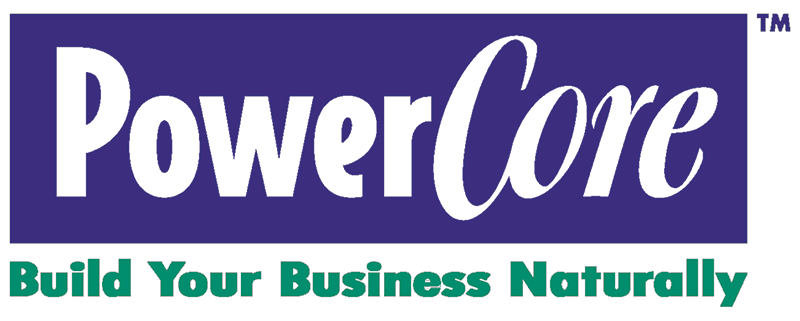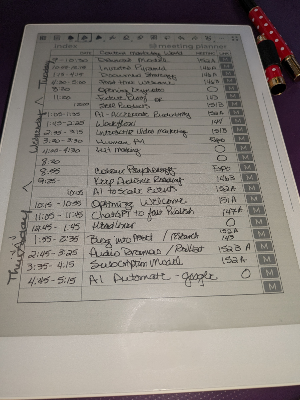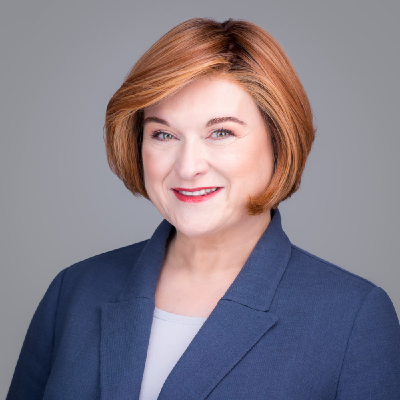(Think of this as an email thread, first content on the bottom, today's new info is here at the top.)
Thursday
8:20 Today's focus was AI. Avinash Kaushik was the opening keynote. He lead with a puzzle: in what order would you stack:
- 9 eggs,
- a laptop,
- a bottle,
- a book, and
- a nail.
for the most stable configuration. Then, he showed ChatGPT's response. AI according to Avinash is a human + a tool then a degree of automation. I kept learning.
8:55 The color psychology demo was for interior designers. Put in a word, an emotion that you want your client to feel, and AI gives a color palette. Reminded me of a 7-Minute Julie, a florist, did at Cumberland, where she showed what flower she selected for a wedding based on how the bride wanted her guests to feel.
9:25 Mark Bornstine shared how to use AI to scale events. He made my top 7 presenters list. Big take away - what wasn't available to us seven months ago. This is moving fast.
10:15 Amy Balliett, How to Use AI for Content Design, was my second favorite presenter of the entire conference. Her focus was toolsets in three categories (She was the second person to talk about MidJourney.) And she gave a complex prompt chart. Prompts are the magic. Practice prompts.
11:05 Use ChatGPT to Turn Transcripts into Published Content was presented by Kayla Mehorja of Wordpress VIP - the enterprise section of Wordpress. She gave great pros-and-cons lists, great prompts lists, and excellent examples on screen. Her key message: start with a human, human in the middle, end with a human. Don't skip the human.
12:45 Derek Thompson, last night's keynoter, interviewed Elizabeth Banks. She shared deeply about all of her business adventures - starting with acting, then directing and writing and producing; now Archer and Roose - (wine in a can - so you can bring it to a game and the river, like beer!) - and how she accepted the challenge of podcasting. She was prepared with a prop (she likes props!) and two videos that showed her purpose. Derek and Elizabeth demonstrated why some people have success: they are prepared.
1:55 How to Turn a Blog into an Asset was a phenomenal case study from Saatva that covered five years and showed the costs and return on investment from focusing on the client, instead of the product. This was an excellent example of what happens when you know your client. I have a list.
2:45 Audio Dramas was a brief introduction into the ability of four platforms, including Discord and Alexa, to allow a listener to "choose their own adventure." Interesting. Seems like a lot of work. Not for me right now.
3:35 How to Turn Your Content into a Subscription Model. Think Netflix, and overlay your content. You have content - you have your InfoMinutes and 7-Minutes, and emails answering client questions. You have content that could be leveraged for subscriptions and affinity marketing.
4:45 Closing keynote, Whose job is AI going to take?, by Cassie Kozykov, from Google. First: AI has been around for 6 years, it's just now getting smart enough for us to use. Second, there are four steps: data (ingredients), algorithms (appliances), models (recipes), predictions (dinner). there is a fifth, but we're not there yet - data products. Her analogy is that AI will never be, in the recipe model, a Michelin starred chef. AI will always need a human. You have a microwave, don't you? It's a tool, an appliance. So is AI. Use it. Use it for "thunking" - the execution, because humans excel at "thinking" - the creativity. Take a walk and think, let AI thunk.
I have other batches of thoughts, about 7-Minutes and Best Clients; about the number of things I saw that showed the zeitgeist, about backpacks and rollie carts and how much people schlepp, about capturing on my Supernote and the fact that I only saw one other person using eInk (an rM2), and overheard only one person ask for a business card; about the benefits of a walking city - I walked back to my hotel each day, that was a treat, and not something I would be able to do in Johns Creek or Peachtree City. The conference was organized efficiently from check-in badge to app; the signage was useful and helpful, the meals were efficient from distribution to cleanup.
I'm pleased with what I made myself do (say hello to the person sitting beside me, and start a conversation) and allowed myself not to do. Most of all I'm clear this was a springboard, and the benefit will come as I focus on my top three action items, and dig deeper.
Wednesday
SBT from this morning's keynote: "Content is not just an opportunity, it's a responsibility." Same is true for effective InfoMinutes, which I'm learning as people ask me what I do. Best response so far: "That's interesting," followed by a question from one of the marcom guys for Traveler's Insurance. He's responsible for 70 pages on the Traveler's website. That's his whole job. Content is a responsibility.
Bevery Jackson, VP of Brand and Product Marketing at Zillow, shared how they've refreshed. She used a case study format, showed before and after, and walked through the change of focus from "what we do" to "what our client's are looking for." This focus on the client has been a common theme. Advertising is benefiting from referral marketing concepts.
Ben Johnson from the American Marketing Association announced a joint-certification program with Content Marketing Association. Two of the modules are storytelling and story mapping. There's opportunity for us here.
Ann Handley and Andrew Davis took questions Jeopardy style. My big takeaway was their repeated emphasis on strategy. Do Fill the Filing Cabinet, plan an editorial calendar. Measure, adjust, repeat. That's strategy.
Melanie Deziel was my reason for being there. YOWZA. Her topic was: "What's the BIG Idea? Creating Content that Makes an Impact." She was prepared (many speakers are winging it), polished, professional - she didn't apologize (I have stories) or meander. Her slides were effective (I think I can show you - ask me if you're interested) And my SBTs from her include her response to a question, along with ideas you'll experience in the October Coaches Workshop on Purple Cards. Her books are The Content Fuel Framework and Prove It. These will be on my list for PowerReaders. I'm also going to check out her learning lab, CreatorKitchen.
At "You Can Do Both: Drive Thought Leadership and Sell Products", the presenter was having tech difficulties and gave a perfect Purple Card - she wanted to use presenter's view, so she could see her notes on her laptop without showing them on the screen. Wasn't working; then on her third slide she said: "I'm a mom, so I can always figure out how to solve a problem," she held up her phone, "I can get my notes on my phone." Exceptional Purple Card. Model that. What are you able to do because you're a (insert role)?
Lunch was at a table of eight, where I met the guy from Traveler's. He had been in the same two morning sessions I was at, so we shared with the table how effective Melanie Deziel had been.
My first afternoon session was about journey mapping - new information for future Best Client workshops.
Carmen Hill from Chill Concepts presented story mapping. She shared the link to her template. This will come up in Fill the Filing Cabinet and in Best Client.
Tony Gnau presented An Interactive Plan for Video Marketing Success. He was the first person to use a handout. (A couple of presenters could have - I've seen several handoffs, i.e. sales pieces.) He is an accomplished storyteller, with very strong stage skills. He'll show up in Best Client and in the new Extra Extra workshop about multi-purpose marketing with 7-Minute presentations. He feels strongly that video is about emotion, no facts or data. The Red Card from InfoMinutes, not the whole InfoMinute.
The closing keynote was by Derek Thompson, a writer for The Atlantic, and the author of Hit Makers (2017) I read it back then, nice to see him in person - and it has potential for PowerReaders. He published a book last year that I'll get, and there's a new one coming next year. If you enjoy reading Malcolm Gladwell - oh! Same editor! And Atul Gawande, too. Got it.
And with that, I walked back to my hotel, toasted.
There were two social events, but . . . not for me tonight, I am full.
Tuesday
Today was three deep dives and an orientation. Reminded me of Information Monday!
The Diamond Model for Content Marketing 90 minutes
There are five facets to this diamond. In large letters I wrote, and highlighted FOCUS ON ONE GOAL.
Their tool is:
"Our content is where (audience X) gets (information Y) that offers (benefit Z)."
This would be a good referral trigger exercise. Could be a good 7-Minute outline, too.
Monday, I'll share their focus for the advertising drawer at How to Build - it will make that part much easier.
Their workbook link is bit.ly/CMW23-DIAMOND
The Inverted Pyramid 90 minutes
This is the story-telling system Quentin Tarantino uses. The presenters began by listing his movies, then giving examples of him using the formula.
I'm wondering ... if ... in an InfoMinute ... it would be effective to start with the Story (Red Card), and tell it backward. The standard story template is:
- client's problem,
- my action,
- client's result.
Tarantino does it:
- Client's result,
- because of my action,
- which solved this problem.
Two other things that made me consider:
- Don't start from scratch - spruce things up. (Do this with an InfoMinute you've already written.)
- Speak from the user's perspective. This point was made in the first session, too - effective content addresses the result the client is looking for. Advertising is what the business wants to tell and sell. Content is not advertising.
That's why the words under the logo on a PowerCore Member's personal profile page have to be about the result the client wants.
Document Strategy 3 hours
HUGE take-away was where web traffic comes from:
- 60% for B2C, 64% for B2B is from search. That's content.
- 19% is from referrals
- 1% email marketing
- 2% social media
- 3% paid online advertising
Takeaway: put InfoMinutes on your website as articles and blogs for a +60% benefit.
Content length - never less than 1,000 words; 1,500 to 1,750 is effective, too.
This was surprising to me. I'll bet I often stop too soon.
Content marketing is an investment, with real value, that grows over time. (He shared the patterns for three graphs.)
First Timer Orientation 45 minutes
I counted over 225 people in the room. Total registration is rumored to be 2,500. This is year 11.
The format was familiar - a moderator and three panelists!
They had good systems in place that I'm going to consider for PowerCore. For example,
- if you didn't have dinner plans go to the back of the room and get placed with three other people.
- Wonder how this would work at Orientation Essentials.
- What if new Members could ask to be assigned to have lunch and talk about subbing, or do a PowerPerk, or get personalized information on how to give referrals, like Donna gave Tanner at Officer Training.
Tommorrow starts at 6am with a choice of yoga or a 3 mile run.
Right.
This year I chose Content Marketing World.
There are 153 breakout sessions, in 25 tracks. To prepare, I made a spreadsheet that includes every title and presenter I think I'd get benefit from. Each session had 4-6 options. Can't do it. So, I narrowed to my top two in each session. I've got a list, that includes the room number - I'll sit by the door, and at the seven minute point make the decision to stay or hop rooms!
Changing rooms has built in drawbacks:
- I'll miss the pre-marketing time. When people do that at Information Monday I always feel sorry for them - I see how they miss what could have been. Do I really want to choose that?
- I'll miss the first words. I know the cost of that - it's huge - how will I overcome my preconceptions?
- And what if I don't like the content in session two any better than the first one? By then it will be 20 minutes in, would I really want to hop to a third room?
All knowledge is like that - making one choice means giving up another option. George's position is: "Everything I do brings benefit." Here's my decision: at the end of each day I'll share my single best things. Perhaps the reason I chose a session is because you needed it! Bookmark and come back here every day this week to see what I'm learning.
Because new knowledge stirs up referrals
- W!


